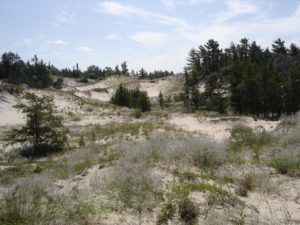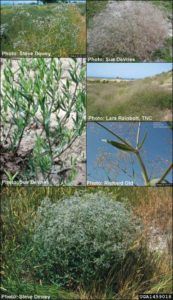Baby’s Breath
 At first glance, you might recognize Baby’s Breath, its the little white flower that is usually used as a filler flower in bouquets at special events. Very few people know the true negative impact this small flower has had on the dunes regions in the Great Lakes Region particularly along Lake Michigan.
At first glance, you might recognize Baby’s Breath, its the little white flower that is usually used as a filler flower in bouquets at special events. Very few people know the true negative impact this small flower has had on the dunes regions in the Great Lakes Region particularly along Lake Michigan.
The origin of Babys Breath is uncertain some say a florist in Frankfort Michigan found it and started to use it and its popularity spread nationwide, but that is basically Michigan lore at this point. We do know that its original origins are from Europe and most likely made its way over to North American through humans. What we do know is that it is very established in the dune regions in Michigan and it is causing massive problems.
problems.
It starts with the structure of the plant. Baby’s Breath has a long and sturdy taproot that when fully matured can reach a few feet into the dunes, this anchors the entire root systems. Then above ground, there is an entire shrub that can grow up to about 3 feet tall it flowers and then once the flowering season has come to an end, the bush snaps off and basically becomes a tumbleweed and with the help of the wind, it disperses the seeds all over the dunes. This distribution method makes monocultures of Babys Breath a very real problem around Lake Michigan. Once the plant is established, Baby’s Breath can spread quickly by its many windblown seeds, since there can be up to 13,000 seeds per plant. Baby’s Breath out-competes native plants and takes over their habitat while providing no food or habitat for native wildlife. Its threatening native plants like wormwood, broomrape, and the threatened Pitcher’s thistle.
According to the Detroit Free Press who recently published an article on this plant,” Invasive plants, such as baby’s breath, often result in the loss of native plants in the dunes that eventually transition into a “closed-canopy forest,” or trees and leaves form a ceiling. ” This is a massive problem when it comes to the biodiversity and ecology of this fragile and ever-evolving region in the Great Lakes.
“It can change the dunes and choke out native plants,” said Katie Grzesiak, invasive species network coordinator with Northwest Michigan Invasive Species Network (MISIN).
The best way to dispose of Baby’s Breathe is to manually remove the top of the taproot by severing it with a shovel and then disposing of the rest of the plant. The chemical application can also be a successful way of preventing the spread of this invasive. Education is the first step to know what is native to Michigan and what is not. You can get more information here !
The post Baby’s Breath appeared first on Michigan United Conservation Clubs.



